Ye Olde Pubs of Tring
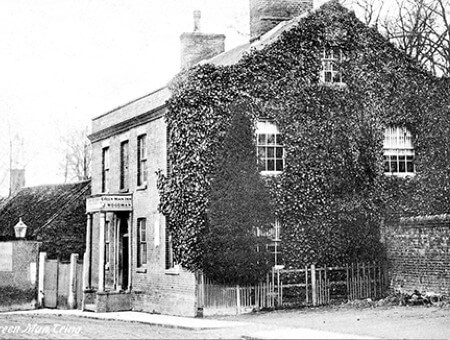
Since lockdown easing, many of us are really appreciating being able to pop to the pub for Sunday lunch or for a quick pint or glass of wine, so it seemed a good time to take a look at the history behind our local watering holes
The number of pubs Tring boasted in the past is often wildly exaggerated, but until the turn of the 20th century, when magistrates started to clamp down on them, there were certainly quite a few. The old town – Akeman Street, Frogmore Street and Market Street (now the lower High Street) – was the location for most of them, with a cluster in the West-end (now ‘The Triangle’) and at New Mill.
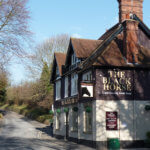
You could have done a pub crawl simply by walking down Frogmore Street, with pubs such as The George and The Victoria all situated on that one street! Formerly a lodging house, The Old Black Horse opened in the late 19th century, one of several Frogmore Street pubs. Lower down were the two Common Lodging Houses, the Black Horse (rebuilt in 1900 by Chesham Brewery) and next to it was the Red Lion, a most disreputable-looking pub. The 1851 census reveals a variety of lodgers, such as an itinerant Italian musician, a sailor and a door mat hawker.
The George (Costa) was the only town centre pub west of the crossroads. It was rebuilt in 1897 by the Aylesbury Brewery Company. Buildings at the rear were once a squash court.
Frogmore Street was densely populated, and until the 1970s had the Victoria, and the Dolphin Inn which, of course, gave its name to Dolphin Square. It ceased being a pub and was converted into a Workmen’s Hall or cocoa tavern by the Reverend Arthur Frederick Pope, in the early 1870s. The Victoria was demolished when the ‘new’ shopping centre was built.
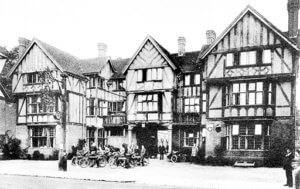
The Bell, dating from the 16th/17th century, has the oldest surviving licence, although the original Rose and Crown was of a similar date. That inn was rebuilt in 1905/6, complete with squash court, bowling green and banqueting hall, all at Lord Rothschild’s expense, and handed over to the Temperance-inspired Hertfordshire Public House Trust – it still sold ale though. The Rose & Crown (along with the Bell Inn) was a staging point for mail and passenger coaches, which ran along the turnpike road between London, Aylesbury and elsewhere.
The Bricklayers Arms is another pub that has long since disappeared. It was situated at the corner of Duckmore Lane, which was known as Bottle Cross. We believe it was named after a nearby house that was decorated with bottles on its wall [we’d love to know if anyone can confirm this story for us!].
To the north, in New Mill, were the White Hart, the Queen’s Arms and until only recently the Pheasant, plus of course the canalside Grand Junction Arms.
Where we now enter the Memorial Garden stood the Green Man (pictured, top) , a handsome porticoed pub whose landlord collected the market tolls. We understand that Walter Rothschild’s pet wolf was once taken there by a groom! The Plough Hotel was at no. 50 – later John Bly’s shop, now Mimi’s. When it closed in 1906 the club room became a rifle range.
In the Triangle area, another pub that called time some time ago was the Britannia. Built in the early 1830s by John Brown, of Tring Brewery, its clients were the navvies who were working on the London to Birmingham railway. You can still see the pub as you come into Tring from Aylesbury, but now it is a private home. The Castle and the Anchor are the surviving pubs most like the ones our forebears knew, when drinking and conversation were the aim and object.
Akeman Street was similarly packed with houses and its residents could choose between the Maidenhead and the Swan at the southern end, and the Royal Oak and the Harrow in the middle. A different sort of customer frequented The Swan in Akeman Street in Victorian times – it was known as the butlers’ pub thanks to its proximity to the Park Street entrance of Tring Park Mansion. Its neighbour The Jolly Sportsman was knocked down to make way for almshouses. The Akeman is of course a recent addition, in what was a private house.
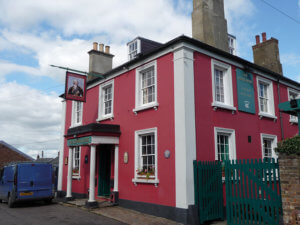
Another pub built for John Brown’s Tring Brewery was the King’s Arms. Built in around 1830, its grounds stretched to the top end of Charles Street – it even had an orchard. Later in the 1800s warehousing and stables were built at the edges of the pub’s land. The King’s Arms even has a literary mention – Berkhamsted author Graham Greene writes in his book A Sort of Life about taking ‘exciting car rides to the King’s Arms in the neighbouring town of Tring’ as a young man in the 1920s.
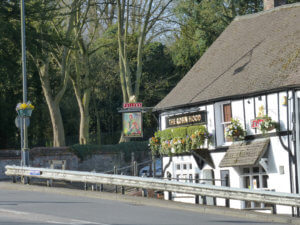
The King’s Arms has an interesting history but not as long as The Robin Hood, which is of 17th-century origin and one of Tring’s oldest buildings. Its sign bracket is clearly the same one that appears in Charlotte Smith’s sketchbook of 1829 (on display in Tring Local History Museum). Thomas James Pearman from Abbots Langley was the licensee in 1901. He was a keen photographer and the pub housed an outdoor studio at the back where he could practice his art.
Finally, in nearby Aldbury the Trooper Alehouse first appeared around 200 years ago. At the start of the 19th century, it was run by Ann Hall and her cousin Martha Parrott. Not only did they run the alehouse, but they also were responsible for the parish post, offered lodging for the needy and even gave out food and drink on prescription! It was renamed the Valiant Trooper around 1890.
As well as Browns brewery, Tring had Liddingtons at Lower Dunsley and Batchelors, later Rodwells, in Akeman Street. Thomas Amsden preceded John Brown at 24, High Street, and his son John brewed in Frogmore Street. One or two pubs brewed their own at different times. A variety of local brewers also supplied Tring, including Wellers of Amersham, Gurneys of Rowsham, Hollands of Wendover and Roberts and Wilsons of Ivinghoe. The pubs of all these breweries, by different routes, were eventually sucked into the hands of one giant, Allied Breweries, meaning that by the 1970s their Ind Coope bitter was almost the only beer available. Only the Rose and Crown, operated by Trust House hotels (and famous for its mournful barmaid Sadie), offered any choice. Fortunately that has all changed, and of course Tring has its own brewery once again.
With thanks to Tim Amsden, Tring Local History Museum and to Mike Bass for the historic photos. You can find Mike at Tring Farmers Market selling local history books and images.

